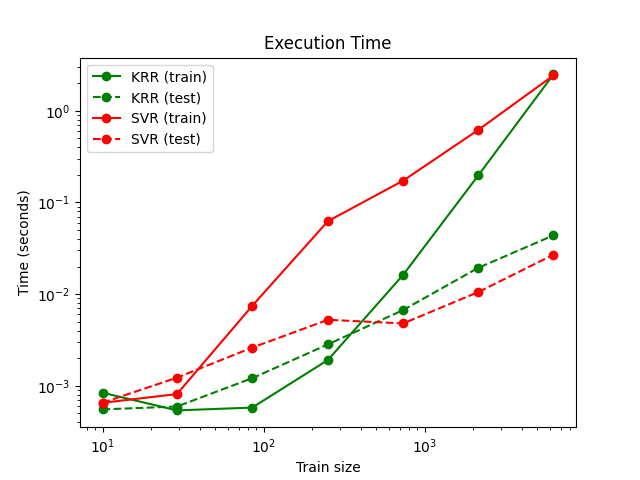1.3. 核岭回归#
核岭回归(KRR) [M2012] 结合 岭回归与分类 (线性最小平方 \(L_2\) - 规范正规化) kernel trick .因此,它学习由各自的内核和数据引发的空间中的线性函数。对于非线性核,这对应于原始空间中的非线性函数。
The form of the model learned by KernelRidge is identical to support
vector regression (SVR). However, different loss
functions are used: KRR uses squared error loss while support vector
regression uses \(\epsilon\)-insensitive loss, both combined with \(L_2\)
regularization. In contrast to SVR, fitting
KernelRidge can be done in closed-form and is typically faster for
medium-sized datasets. On the other hand, the learned model is non-sparse and
thus slower than SVR, which learns a sparse model for
\(\epsilon > 0\), at prediction-time.
下图比较 KernelRidge 和 SVR 在人工数据集上,该数据集由一个sin目标函数和每五个数据点添加的强噪音组成。学习的模型 KernelRidge 和 SVR 绘制了图,其中使用网格搜索优化了RBS核的复杂性/正规化和带宽。学到的功能非常相似;但是,合适 KernelRidge 大约比贴合快七倍 SVR (both使用网格搜索)。然而,100,000个目标值的预测速度快了三倍多 SVR 因为它仅使用100个训练数据点中的大约1/3作为支持载体学习了稀疏模型。

下一个图比较了适合和预测 KernelRidge 和 SVR 针对不同大小的训练集。拟合 KernelRidge 快于 SVR 对于中等规模的训练集(少于1000个样本);但是,对于较大的训练集 SVR 规模更好。关于预测时间, SVR 快于 KernelRidge 由于学习到的稀疏解决方案,适用于所有大小的训练集。请注意,稀疏度以及预测时间取决于参数 \(\epsilon\) 和 \(C\) 的 SVR ; \(\epsilon = 0\) 将对应于密集模型。

示例
引用
“机器学习:概率角度”墨菲,K。P. -第14.4.3章,pp。492-493,麻省理工学院出版社,2012年
